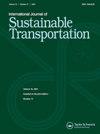关中城市群机动车排放控制策略评价
IF 3.9
3区 工程技术
Q2 ENVIRONMENTAL STUDIES
International Journal of Sustainable Transportation
Pub Date : 2025-10-03
DOI:10.1080/15568318.2025.2531075
引用次数: 0
摘要
了解排放趋势和评估机动车排放控制策略(mvecs)对于促进可持续交通至关重要。本文采用COPERT模型建立了关中城市群的城市排放清单。在此基础上,从排放水平和排放效率两个方面对mvecs进行了评价。在此基础上,定量评价了中国各城市机动车减排潜力。结果表明:广东省机动车PM2.5、CO2和NOX排放量呈上升趋势,VOC和SO2排放量呈下降趋势;排放水平的变化受到车辆类型的强烈影响,重型卡车(HDTs)被确定为二氧化碳、氮氧化物、PM2.5和二氧化硫排放的主要贡献者,而摩托车(MCs)主要是CO和VOC。排放评价分析表明,PM2.5、CO、NOX和VOC对控制策略的响应相似。效率分析结果表明,该流域综合环境效率为0.743,具有显著的减排潜力。以西安为例,CO2、CO和NOX的年减排潜力分别为9.23 Mt、22.7 Mt和27.5 kt。最后,提出了有针对性的协同排放控制和多污染物综合治理策略。本文章由计算机程序翻译,如有差异,请以英文原文为准。
Evaluation of motor-vehicle emission control strategies for urban agglomeration of the Guanzhong region, China
Understanding emission trends and evaluating motor-vehicle emission control strategies (MVECSs) are essential for promoting sustainable transportation. In this study, city-level emission inventories for the Guanzhong urban agglomeration (GUA) were developed using the COPERT model. On this basis, MVECSs were evaluated from two perspectives: emission levels and emission efficiency. Furthermore, the emission reduction potential of motor vehicles across cities in the GUA was quantitatively assessed. The results show that PM2.5, CO2 and NOX emissions from motor vehicles in the GUA showed an increasing trend, while VOC and SO2 emissions decreased. Variations in emission levels were strongly influenced by vehicle types, with heavy-duty trucks (HDTs) identified as the primary contributors to CO2, NOX, PM2.5, and SO2 emissions, while motorcycles (MCs) dominated CO and VOC. Emissions evaluation analysis indicated that PM2.5, CO, NOX, and VOC were similarly responsive to control strategies. Efficiency analysis reveals that the comprehensive environmental efficiency of the GUA was 0.743, highlighting significant potential for emission reductions. In Xi’an, for example, the annual emission reduction potentials for CO2, CO, and NOX are 9.23 Mt, 22.7, and 27.5 kt, respectively. Finally, this study proposes targeted strategies for coordinated emission control and integrated multi-pollutant management.
求助全文
通过发布文献求助,成功后即可免费获取论文全文。
去求助
来源期刊
CiteScore
8.90
自引率
2.60%
发文量
56
期刊介绍:
The International Journal of Sustainable Transportation provides a discussion forum for the exchange of new and innovative ideas on sustainable transportation research in the context of environmental, economical, social, and engineering aspects, as well as current and future interactions of transportation systems and other urban subsystems. The scope includes the examination of overall sustainability of any transportation system, including its infrastructure, vehicle, operation, and maintenance; the integration of social science disciplines, engineering, and information technology with transportation; the understanding of the comparative aspects of different transportation systems from a global perspective; qualitative and quantitative transportation studies; and case studies, surveys, and expository papers in an international or local context. Equal emphasis is placed on the problems of sustainable transportation that are associated with passenger and freight transportation modes in both industrialized and non-industrialized areas. All submitted manuscripts are subject to initial evaluation by the Editors and, if found suitable for further consideration, to peer review by independent, anonymous expert reviewers. All peer review is single-blind. Submissions are made online via ScholarOne Manuscripts.

 求助内容:
求助内容: 应助结果提醒方式:
应助结果提醒方式:


